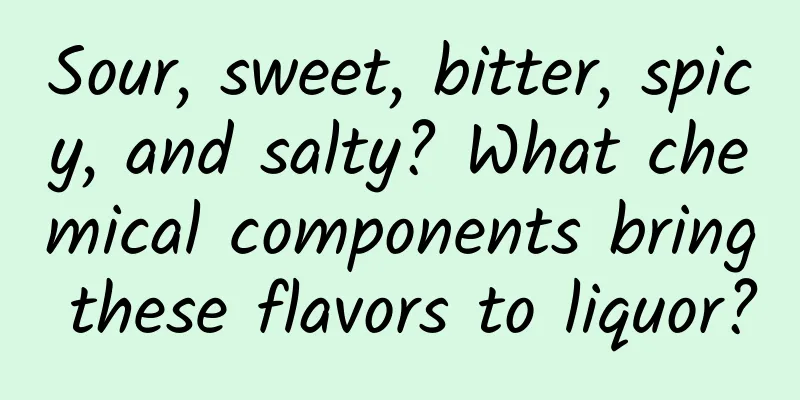Sour, sweet, bitter, spicy, and salty? What chemical components bring these flavors to liquor?

|
Many friends will experience sour, sweet, bitter, spicy and salty flavors when tasting wine. What chemical components bring about these flavors? acid There must be a certain amount of sour ingredients in liquor, and together with other aromatic substances, they make up the aroma of liquor. But the content should be appropriate. If it is excessive, it will not only make the liquor taste rough, but also affect the "sweet aftertaste" of the liquor, and the aftertaste will be short. The main representatives of sour substances in liquor are: acetic acid, lactic acid, succinic acid, malic acid, citric acid, caproic acid and fruit acid. sweet The sweetness in liquor mainly comes from alcohols. Especially polyols, because the sweetness comes from the alcohol group, when the hydroxyl group of the substance increases, the sweetness of the alcohol also increases. Polyols have sweet groups and sweetening groups, which are much sweeter than alcohols with one alcohol group. The main representatives of sweetness in wine are: glucose, fructose, galactose, sucrose, maltose, lactose, hexasol, propylene glycol, 2,3-butanediol, tetrabutylene glycol, pentapentol, diacetyl, amino acids, etc. Among these substances, mainly in the case of an alcohol group with one hydroxyl group, only three molecules of hexanol solution can produce sweetness, which means that the sweetness of substances with more hydroxyl groups increases. It is okay to have a moderate amount of sweetness in liquor. If it is too much, it will not reflect the style of liquor; too little will make the wine taste light and have no sweet aftertaste. bitter The bitter taste in liquor is often caused by excessive higher alcohols, succinic acid, a small amount of tannin, more furfural and phenolic compounds. The main representatives are: quinine (0.005%); inorganic metal ions (such as Mg, Ca, NH3 and other salts); tyrosol, color alcohol, n-propanol; n-butanol; isobutanol (the most bitter); isopentanol; 2-3-butanediol; β-phenylethanol; furfural; 2-ethyl acetal; propenal and some ester substances. hot Spiciness is not a taste, it is a kind of pain that stimulates the nasal and oral mucosa. The spiciness in wine is caused by the burning pain stimulating the pain nerve fibers. Appropriate spiciness has the effect of making the taste buds tense and increasing appetite. However, it is not good for the spiciness in wine to be too strong, and a trace amount of spiciness in wine is also indispensable. The main representative of spicy substances in white wine is aldehydes. Such as furfural, acetaldehyde, acetal, acrolein, crotonaldehyde, tert-butyl alcohol, tert-amyl alcohol, acetone, ethyl formate, ethyl acetate and other substances. astringent Astringency is produced by stimulating the taste nerves. It can coagulate nerve proteins and the mucosal proteins of the tongue, producing an astringent effect, making the taste buds feel astringent, and the mouth, tongue, and palate feel rough. The substances that cause astringency in liquor are mainly excessive lactic acid, tannin, lignin, and acid compounds decomposed from them. For example, substances such as heavy metal ions (iron, copper), formic acid, propionic acid, and lactic acid are astringent; substances such as ethyl formate, ethyl acetate, and ethyl lactate are bitter if they are excessive; and substances such as n-butanol, isopentanol, acetaldehyde, furfural, and acetal are also astringent if they are excessive. salty If there are flavor salts (NaCl) in liquor, it can enhance the sensitivity of taste, make people feel that the liquor is strong, and produce the ester taste of glutamic acid. If there is too much, the liquor will become rough and salty. The salty substances in liquor include halogen element ions, organic alkali metal salts, salt, sulfuric acid, and nitric acid. If there is a little excess of these substances in liquor, the liquor will taste salty and damage the flavor of the liquor. Smelly Of course, it is unwelcome to have bad smell in liquor, but liquor contains bad smell components, which are just covered by stimulating aroma substances and are not prominent. First, low-quality liquor and new liquor have obvious bad smell. Second, when a certain aroma substance is too strong and too prominent, it sometimes also presents bad smell. Bad smell is an olfactory reaction. A certain fragrance is considered as bad smell when it is abnormal. Once there is a bad smell, it is difficult to eliminate and needs to be covered by other substances. The bad smell in liquor includes: hydrogen sulfide smell (such as rotten eggs and stinky tofu), mercaptan (ethyl mercaptan, like the smell of stinky and spicy burps after eating raw radish, and the smell of leek and cabbage). Substances that can produce bad smell in liquor include hydrogen sulfide, mercaptan, fusel oil, butyric acid, valeric acid, caproic acid, ethyl sulfide, free ammonia, acrolein and pectin. Oil The flavor of liquor is incompatible with the oily taste. Even a trace of oily taste in the liquor will seriously damage the quality of the liquor, and the liquor will taste rancid. This is because the liquor contains various oily ion substances. bran The bran taste in liquor is mainly the result of not paying attention to the selection and processing of auxiliary materials, which makes the liquor taste like raw husks. mold The musty smell in wine is mostly caused by the mildew of auxiliary materials and raw materials. It is mainly caused by the growth and reproduction of mold on clothes during the rainy season, and the mold hyphae and spores are shaken and fly to emit odors. For example, the reproduction of Penicillium and Mucor. fishy The fishy smell in liquor is often caused by iron, often called metallic taste. It is a physiological response with astringent taste produced by the tongue and mouth. The fishy smell in liquor comes from metal ions such as tin and iron. Burnt The burnt smell in liquor comes from careless, irresponsible and careless production operations. The smell is the smell of burnt materials, for example: when brewing wine, the bottom pot is burned dry due to insufficient water, and the bran, dregs and sediments in the pot are burnt and emit a strong burnt smell. However, after five rounds of brewing, the sauce-flavored liquor will have a slight burnt smell, which is normal and not a foreign smell. Source | Chemistry Cool, copyright belongs to the original author, if there is any copyright issue, please contact us in time to delete it. |
>>: This year's hole on Earth, which is bigger than Antarctica, was created by a volcano!
Recommend
The new generation of MacBook Pro has many problems. Do you still dare to buy it?
Since the release of the new generation of MacBoo...
7 Predictions for Metaverse Immersive Marketing
According to the first principles, the biggest me...
Is our love of drinking determined by our genes?
Leviathan Press: Both the United States and the S...
SaaS product promotion and customer acquisition guide!
Today, let’s talk about how to achieve rapid and ...
User growth analysis: How to segment users?
Introduction: In the growth analysis of a product...
Detailed explanation of common methods of Android audio acquisition
Preface Android Audio Collection There are genera...
Until 3,000 years ago, the human brain was in a "split" state?
Leviathan Press: The "two-mind hypothesis&qu...
Are humans still evolving today?
Are humans still evolving today? Author: Mao Ning...
Taiwan's Internet Addiction Treatment Authority" Ke Huizhen x 8 videos
Taiwan's Internet Addiction Treatment Authori...
Can you hypnotize a chicken by drawing a line in front of it? What kind of outrageous hypnosis is this?
In a video, we can see the following scene: A chi...
A successful H5 should hit the user's key points and achieve the operation purpose
Without discussing how to define “success”, can y...
One billion snow crabs mysteriously disappeared, and not being able to eat crab legs is just a trivial first step
Red snow crab legs as long as your arm are the cr...
How much is the cost of custom development of WeChat mini programs in Chengdu? Introduction to Chengdu mini program development companies
Now, mini programs seem to have become a must-hav...
100 seconds to review the wonderful content of "Universe-level online course"
This afternoon The third lesson of "Tiangong...
2021 Douyin does not require fans to open a showcase (how to open a product showcase with 0 fans)
01. Douyin launches product showcase I believe al...









